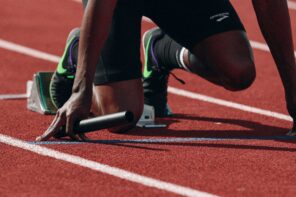It can be easy, from our lofty cushioned couches and recliners, to cast aspersions on any athlete who doesn’t live up to the standards we’ve imagined for them. The moral failings of athletes are often treated with greater scrutiny than that of politicians and litigators, most especially when they are caught cheating. Just look at “Rocky IV”, king of all films about politically-charged at hletic tropes. While Rocky is working himself into mental and physical fitness in the toughest conditions, the antagonist Ivan Drago is seen icily receiving a particularly juicy shot to the arm in a laboratory-like training room, heavily implied to be anabolic steroids.
As if killing Apollo Creed wasn’t enough, Drago ingratiates himself further by trying to get ahead, solidifying his status as the series’ most unforgivable villain. Instead of aiming to prove himself by his own grit like the admirable Rocky, he cuts corners to win at all costs. We never find out why Drago took that shot, or who provided it to him. For many, it’s an irrelevant line of questioning.
Performance-Enhancing Drugs are simply too much of a pocket advantage for the sports they affect for society to justify them. The common tendency to moralize an athlete’s behavior is a core cause of this perception, this need to protect the idea that sports are the last bastion of meritocracy. In truth, the reasons for using PEDs are more complicated than this type of snap, moral judgment allows for.
The common tendency to moralize an athlete’s behavior is a core cause of this perception, this need to protect the idea that sports are the last bastion of meritocracy
The body of an athlete is similar to a car, in that almost every facet affects its value in the market. For many athletes, a major injury, especially one to the lower body like a torn ACL, ruptured Achilles, torn Meniscus, or even broken bones can permanently alter one’s ability to perform, even after a full recovery is made. PEDs offer a boon to recovery times which can be invaluable. For example, Human Growth Hormone, one of the more ubiquitous PEDs, stimulates a hormone called IGF-1 which helps your body create cartilage and bone. For a number of injuries, this can drastically improve recovery time. Additionally, HGH use after an injury can help minimize side effects. One of the most common side-effects of being injured is having long-term strength loss due to muscle atrophy, which HGH counteracts by encouraging muscle growth.
Of course, this is not the only usage for HGH or PEDs. Many athletes choose to use PEDs merely to gain a competitive edge, regardless of whatever their standing in their field may be. When I say “many”, I mean exactly that. At the London Olympics in 2012, for example, over 143 athletes were caught doping, 43 of them medalists. Some estimate doping rates amongst athletes to be as high as 40% of all participants. For many, this is unconscionable, and it violates what we might consider the ethics of athletics.
The World Anti-Doping Agency, for instance, describes what they consider to be the “Spirit of Sport,” which encompasses all that people find inherently valuable about performing a sport. These ethics include values like fair play, determination, health, excellence in performance, and dedication; all qualities that most people can agree are admirable. We expect and even demand this of our athletes. We want to know that they are pushing themselves to their absolute limits to earn our admiration. A large part of that pursuit is accepting that the risk of failure is part of the equation.
For many, knowing an athlete has used a PED to elevate their level of performance desecrates this noble pursuit. When Ben Johnson set a 100m World Record but was then caught having used stanozolol, we felt like he tried to trick us. But Ben Johnson was already at the highest level of his sport, and as his coach and many others in the sporting world would claim, everybody was already taking. When that is the case, when the spirit of the game is already lost, is it the athlete’s responsibility to take one on the chin? When an athlete cannot hope to recover from an injury within enough time to survive roster cuts, should we impugn them for not accepting the death of their long sought-after career with grace? Sports and its accompanying media, despite all that it has come to represent morally, has turned a blind eye towards those considerations.
What constitutes the “spirit of sport” is a tricky, if not impossible term to define, especially when it comes to opinions about athletes and PEDS. Many use the term as grounds to prohibit PEDs, claiming that drugs corrupt the “natural” level of performance. The problem is that the natural level of athletic ability is indeterminable, which is why the question of PEDs remains complex.
I, for one, am generally opposed to legalizing PED use in competition. There are arguments to be made that PEDs, specifically the Human Growth Hormone, or HGH, help athletes recover from injuries more quickly. There are also compelling arguments that the drug classification, testing, enforcement, and punishing systems used by sports’ most powerful governing bodies, such as the NFL or the IOC, are outdated at best, and corrupt and discriminatory at worst.
There are also compelling arguments that the drug classification, testing, enforcement, and punishing systems used by sports’ most powerful governing bodies, such as the NFL or the IOC, are outdated at best, and corrupt and discriminatory at worst.
From athletes being tested “at random” after a stand-out performance, to using drug testing as a back-door method to punish athletes for marijuana use, there is no denying that the system for testing for PEDs needs reform. Yet lately, perhaps a more popular position than reformation has been abolishing the restriction of PED use altogether. This is a dangerous path that has the potential to corrode the very core of what makes watching and following professional sports so compelling—that intrinsic, unquantifiable combination of talent and determination that distinguishes stars from average players.
Great athletes are psychologically compelled to do everything in their power to outmatch their peers. That is the idea behind championships—they reward those who achieve the highest standard. Now, the nature of that standard is fluid and dynamic. It has little to do with a measurable benchmark, say throwing for 50 touchdowns, and everything to do with the simple task of outdoing the competition, whether that be by the greatest or slimmest of margins. Under a framework in which PED use is permissible, athletes will be driven to use to gain a competitive advantage. We may see father hit home runs, faster slapshots, and previous sprinting records being eclipsed over and over as a result of athletes’ drug-enhanced biological makeup.
Great athletes are psychologically compelled to do everything in their power to outmatch their peers.
But what happens next? More and more athletes see the athletic achievements of those that use PEDs, and, as their competitive instincts dictate, they begin using too. All of the sudden, any competitive advantage gained by those original few that used disappears as the mean athletic level catches up to them. This may not seem like a big deal, except for one key difference—now, athletes seeking to gain a competitive advantage have an additional option available that was not available to everyone initially: to take more drugs. And so, the cycle persists. By legalizing the broad use of PEDs in sports, we are encouraging a culture of one-upmanship based on the mindless injection of hormones, not of improvement through training, dieting, or any other means that require discipline.
What makes professional athletes incredible role models is their seemingly innate ability to persevere. While a genetically acquired athletic skill set is necessary for professional success as an athlete, I believe that truly successful athletes succeed because of an intrinsic drive for excellence. Take as proof both the incredibly high percentages of privileged children who were given every resource—be it a home gym, dieticians, physiotherapists, sports science technology— only to fizzle out before the pro level because material advantages alone do not guarantee success.
The shared characteristic in each case is clear—both lack that fundamental drive for greatness. The drive to achieve the highest standards and to surpass your peers at every level. the same drive that would push nearly every athlete into PED use if given the opportunity. The thing is though, under the current framework of banned PED use, we can admire the determination of athletes who achieve greatness, use that motivation to drive success in our own lives, and respect the blood, sweat, and tears that forge every athlete. Under a framework of legalized PED use, this admiration becomes diluted.
At the highest level of sport, where the margins are razor-thin, and winners are differentiated from losers by fractions of a second, ounces of strength, and millimetres of distance, a biological enhancement will undoubtedly become the deciding factor. The winner will be the one with the highest dosage or the best combination of drugs, not the one one who rose above the field through some magical combination of sheer will, skill, and yes, luck.








